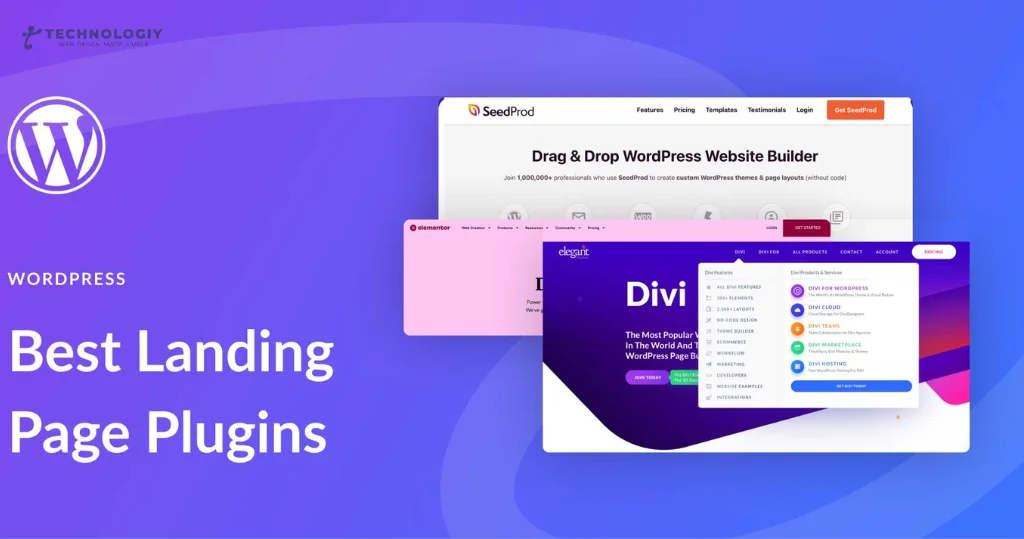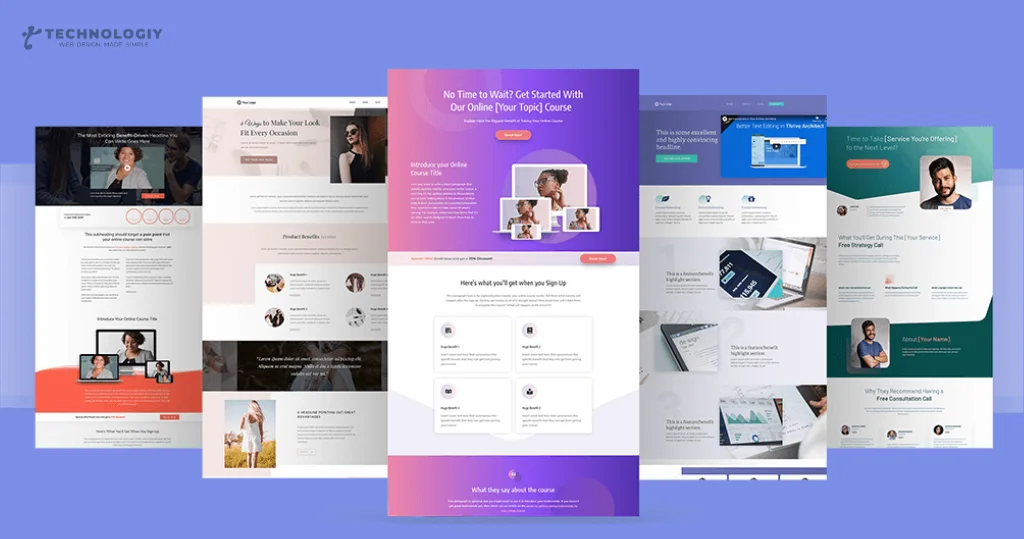The Significance of Landing Pages in WordPress In today’s digital age, having an online presence is crucial for any business or organization. And when it comes to creating a professional and effective website, WordPress is a popular choice for many. But there’s one aspect that often gets overlooked – landing pages. Landing page design for WordPress is not only essential but also plays a significant role in driving conversions and achieving marketing goals. In this blog post, we will explore the significance of landing pages in WordPress and why you should pay attention to their design.
So why are landing pages so important in WordPress?
Here are a few reasons:
First and foremost, let’s understand what a landing page is. A landing page is an independent web page designed specifically for a marketing or advertising campaign. Unlike other pages on your website, landing pages are designed with a single goal in mind – to convert visitors into leads or customers. Whether it’s capturing email addresses, promoting a product or service, or driving registrations, landing pages are a powerful tool in your online marketing arsenal.
Increased Conversion Rates:
Landing pages have one purpose – to convert. By focusing on a specific offer or message, you can eliminate distractions and guide your visitors toward taking the desired action. With a well-designed landing page, you can significantly increase your conversion rates and achieve your marketing goals more effectively.
Tailored User Experience:
Unlike your homepage or other website pages, landing pages are designed with a specific target audience in mind. You can customize the content, layout, and design elements to match the interests and preferences of your target customers. This tailored user experience creates a stronger connection with your audience and increases the chances of conversion.
Easy Integration with Marketing Tools:
WordPress offers a wide range of plugins and integrations that can enhance the functionality of your landing pages. From email marketing tools to CRM systems, you can seamlessly integrate your landing pages with various marketing tools to streamline your campaigns and track your results effectively.
Improved SEO Performance:
Landing pages can also contribute to your website’s overall SEO performance. By optimizing your landing page content with relevant keywords and meta tags, you can improve your chances of ranking higher in search engine results. This increased visibility can drive more organic traffic to your website and ultimately lead to higher conversions.

A/B Testing and Optimization:
Landing pages provide an excellent opportunity for A/B testing and optimization. By creating multiple versions of your landing page and testing different elements such as headlines, images, call-to-action buttons, and form fields, you can identify the most effective design and content combinations. This iterative process allows you to continuously improve your landing pages and achieve better results over time.
Essential Elements for Effective Landing Pages In today’s digital age, having a well-designed landing page is crucial for the success of your website. Whether you’re promoting a product or service, or simply trying to capture leads, an effective landing page can make all the difference. In this blog post, we will explore the essential elements that make up a successful landing page design for WordPress.
Clear and Compelling Headline:
Your landing page’s headline is the first thing visitors see, so it needs to grab their attention and clearly communicate your offer. Employ compelling and persuasive language to captivate visitors and encourage them to delve deeper into your content.
Engaging Content:
The content on your landing page should be concise, engaging, and focused on the benefits of your offer. Utilize bullet points, subheadings, and visuals to segment the text and enhance its readability. Remember, visitors have short attention spans, so make every word count.
Call-to-Action (CTA):
A strong and prominent call-to-action is a must-have element for any landing page. Whether it’s a “Sign Up Now,” “Download Now,” or “Get Started Today” button, your CTA needs to be visually appealing and persuasive. Additionally, make sure the CTA stands out from the rest of the page to grab visitors’ attention.
Captivating Images and Videos:
Visual content is a powerful tool for capturing and retaining visitors’ attention. Use high-quality images and videos that are relevant to your offer to enhance the user experience and increase engagement. Videos, in particular, can be highly effective in explaining complex concepts or showcasing product features.
Social Proof and Testimonials:
Building trust with your visitors is essential for a successful landing page. Incorporate social proof elements, such as customer testimonials, reviews, or case studies, to show that others have benefited from your offer. This helps to alleviate any doubts or hesitations potential customers may have and encourages them to take action.
Mobile-Friendly Design:
Given the growing prevalence of mobile devices, it is essential to have a landing page that is optimized for mobile viewing. Ensure that your landing page design is responsive and adapts seamlessly to different screen sizes. This will provide a better user experience and prevent potential visitors from bouncing off your page.
Easy-to-Use Form:
If your landing page includes a form for lead generation, make sure it is user-friendly and requires minimal effort to complete. Keep the form fields simple and only ask for essential information. The fewer steps and fields visitors have to fill out, the more likely they are to convert.
Clear Navigation:
While landing pages are typically designed to be standalone and focused, it’s important to provide visitors with clear navigation options. Include a minimalistic navigation menu that allows visitors to explore other relevant pages on your website if they choose to do so. This can contribute to enhancing the overall user experience and lowering bounce rates.
A/B Testing and Data Analysis:
To continuously improve the effectiveness of your landing page, conduct A/B testing to compare different variations of your design, content, or CTA. Analyze the data and make data-driven decisions to optimize your landing page’s performance and conversion rate.
Landing Page Design for WordPress:
Getting Started Building Your First WordPress Landing PageAre you ready to take your website to the next level? If you’re looking to increase conversions and drive more leads, then it’s time to start building your first WordPress landing page. In this comprehensive guide, we’ll show you everything you need to know to get started with landing page design for WordPress.
Why Landing Pages Matter?
Firstly, let’s talk about why landing pages are so important. A landing page is a dedicated page on your website that is specifically designed to capture the attention of your visitors and guide them toward taking a specific action,
Examples include making a purchase, subscribing to your newsletter, or downloading an ebook. Landing pages are powerful marketing tools that can significantly boost your conversion rates and help you achieve your business goals.
Choosing the Right WordPress Theme
The first step to building your WordPress landing page is selecting the right theme. Luckily, there are plenty of themes available that have been specifically designed for creating effective landing pages. Look for a theme that offers a variety of customization options, such as different layouts, color schemes, and font styles. You’ll also want to ensure that the theme is responsive and mobile-friendly, as a large percentage of web traffic now comes from mobile devices.
Installing the Necessary Plugins
Once you’ve chosen your theme, it’s time to install the necessary plugins to enhance the functionality of your landing page. One essential plugin is a form builder, which allows you to easily create and manage opt-in forms for collecting visitor information. Another useful plugin is a page builder, which enables you to create visually appealing and highly customizable landing page layouts without any coding knowledge. Additionally, consider installing an analytics plugin to track the performance of your landing page and make data-driven improvements.
Designing an Eye-Catching Layout
Now that you have your theme and plugins in place, it’s time to start designing your landing page layout. Keep in mind that a successful landing page should have a clean and uncluttered design, with a clear and compelling headline, concise and persuasive copy, visually appealing images or videos, and a prominent call-to-action button. Use high-quality graphics that resonate with your target audience, and make sure your content is easy to read and understand.
Crafting Compelling Copy
The copy on your landing page is crucial for capturing your visitors’ attention and convincing them to take action. Make sure your headline is attention-grabbing and speaks directly to your audience’s pain points or desires. Utilize persuasive language and emphasize the primary advantages of your product or service. Keep your paragraphs short and concise, using bullet points or subheadings to break up the text. Remember to incorporate social proof, such as testimonials or case studies, to establish trust and credibility.
Optimizing for SEO
To ensure your landing page gets maximum visibility and organic traffic, it’s important to optimize it for search engines. Research and include relevant keywords throughout your copy, title tags, meta descriptions, and image alt tags. Use descriptive URLs and create a sitemap to help search engines crawl and index your landing page. Additionally, make sure your landing page loads quickly and is mobile-friendly, as these factors are important for search engine rankings.
Testing and Optimization
Once your landing page is live, it’s crucial to regularly test and optimize it for better performance. Conduct A/B testing to compare different elements of your landing page, such as headlines, call-to-action buttons, or form designs, and analyze the results to make data-driven improvements. Monitor your landing page’s analytics to understand how visitors are interacting with your page and identify any areas for improvement. Remember, landing page optimization is an ongoing process, and even small tweaks can lead to significant improvements in conversions.
In conclusion, becoming proficient in expert landing page design for WordPress involves a blend of audience understanding, goal setting, persuasive content creation, user-centered design, and relentless optimization. By following the principles outlined in this guide and staying committed to enhancing your landing pages, you can achieve remarkable conversion results and drive your online success to new heights.
